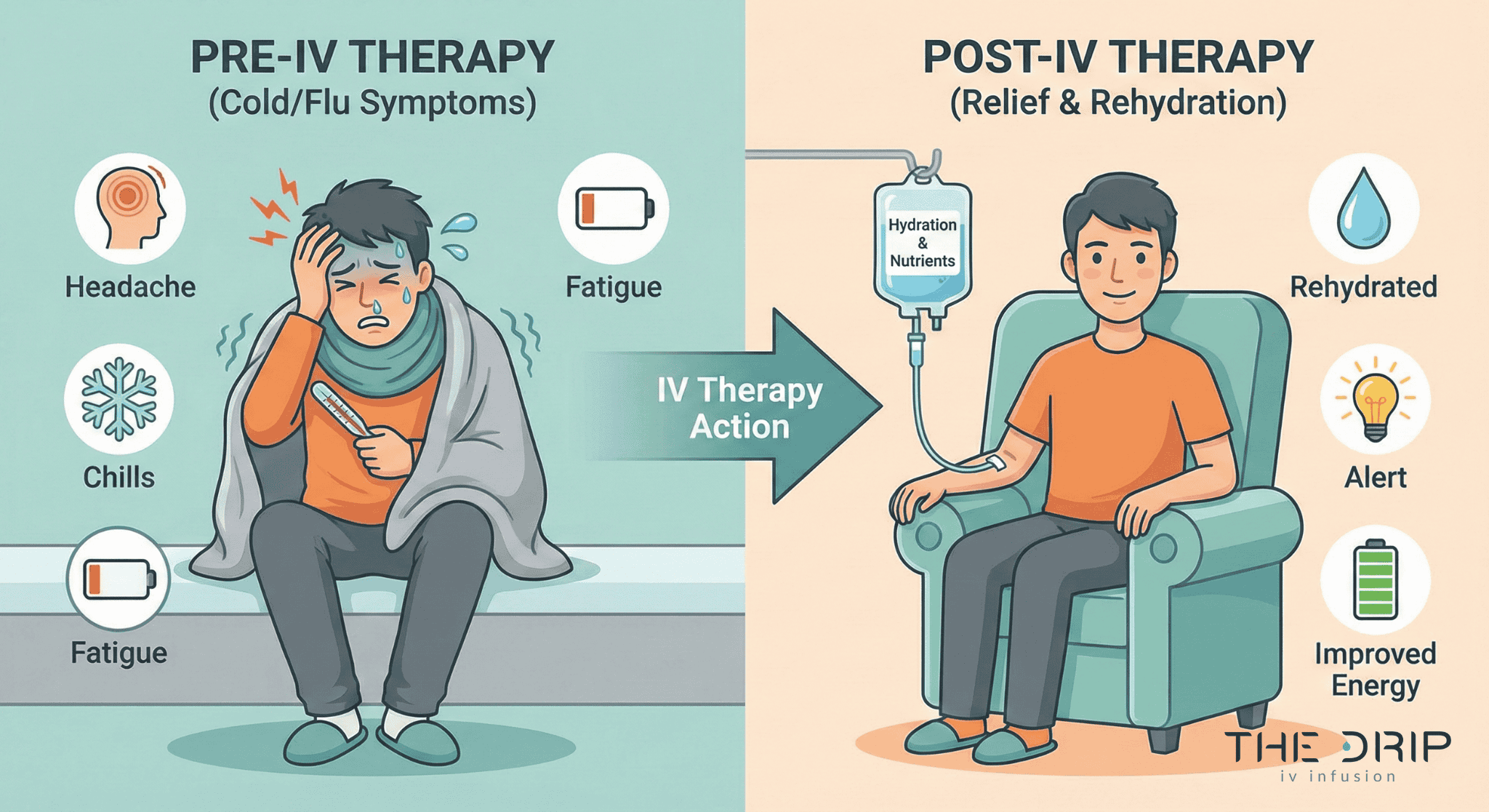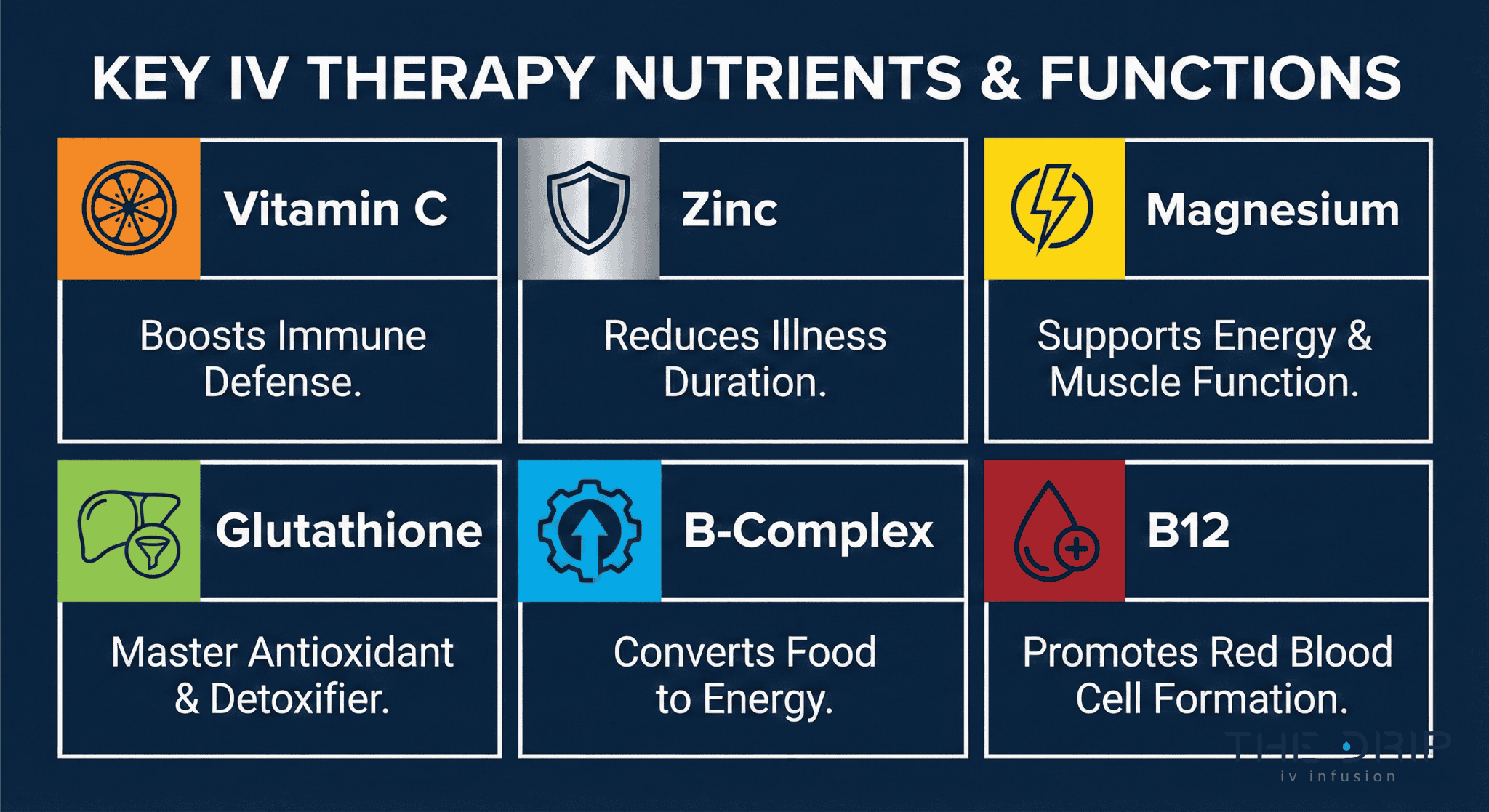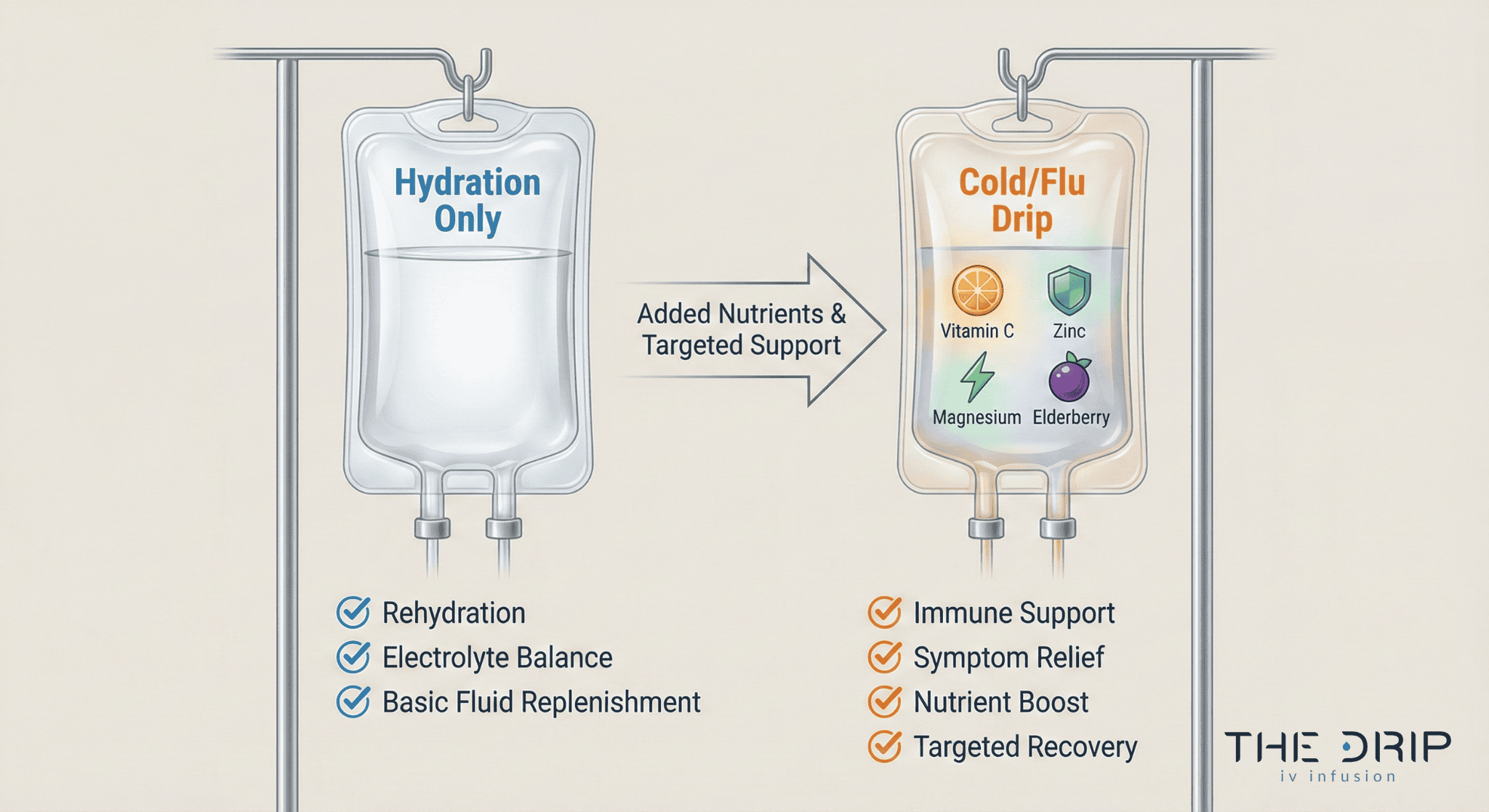IV therapy supports recovery from cold and flu by delivering fluids, vitamins, and minerals directly into your bloodstream for faster absorption than oral supplements. If you’re fighting a cold or flu and thinking about IV therapy to get better faster, you’re probably wondering if those trendy drips can really help you feel better sooner. We get it—when you’re sick, you’ll try almost anything for relief, and we’re here to give you straight talk about what IV therapy can and can’t do for your symptoms.
IV therapy for cold and flu is when doctors put fluids, vitamins, and minerals straight into your blood through a vein in your arm. It skips your stomach completely, so your body gets nearly 100% of what’s in the drip compared to only 10-50% when you swallow pills. This treatment used to happen only in hospitals, but now you can get it at wellness clinics and mobile services that offer special mixes like “Immunity Boost” or “Cold & Flu Drip” packed with high-dose vitamin C, B vitamins, zinc, and other nutrients in salt water.
TL;DR Summary: We’ll look at the usual cold and flu problems that IV therapy targets, like being dried out, tired, and achy, while checking out what vitamins and minerals go into these drips. You’ll learn how IV therapy works from start to finish, how long it takes, and what it costs ($199-$399). We’ll dig into what supporters say it can do, like making you feel better faster and giving you more energy, plus the downsides and risks that top medical centers point out. Finally, we’ll break down different IV mixes and help you figure out what to think about when looking at IV therapy options. Just remember – while getting vitamins through your veins works better than pills, there’s not much solid proof it really helps with colds and flu, according to experts at Harvard Health and Mayo Clinic.
Quick Tip: Before you think about IV therapy for your cold or flu, make sure you’re drinking enough water, herbal teas, and drinks with electrolytes – most people can get better just fine without needles.
As we dig deeper into the science and real-world stuff about IV therapy for cold and flu, we’ll give you what you need to know to decide if this treatment makes sense for your recovery and health.
What Are the Typical Symptoms of Cold and Flu That IV Therapy Addresses?
The usual symptoms of cold and flu that IV therapy goes after are being dried out, worn down, achy, and just feeling awful from virus sickness. IV therapy places market their mixes like “Immunity Boost” or “Cold & Flu Drip” just for breathing illness symptoms. These drips have salt water mixed with vitamins and minerals that are supposed to help your immune system work better.
Commercial IV clinics go after several symptoms at once with vitamin combinations. Most mixes tackle energy drain with B vitamins and fix electrolyte problems with salt water solutions. The next parts look at how being dried out affects getting better, what nutrients providers put in, and how IV treatment compares to drinking fluids.

How Do Dehydration and Nutrient Loss Affect Cold and Flu Recovery?
Being dried out when you’re sick makes it harder for your body to control temperature and move nutrients to your cells. Bad flu cases need IV fluids when people can’t keep down what they drink, especially young kids and older folks. Losing fluids through fever and not drinking enough messes up your electrolytes and slows down getting better.
Dr. Robert H. Shmerling from Harvard Health says most flu patients can drink enough fluids on their own instead of needing IV therapy. Your body loses important minerals through sweating and working harder during virus infections. This dried-out, low-nutrient cycle can make recovery take longer when you don’t fix it.
What Are the Key Vitamins and Minerals Targeted in IV Therapy for Illness?
The main vitamins and minerals in IV therapy for illness are Vitamin C, Glutathione, B vitamins, B12, Zinc, and Magnesium. Getting vitamins through IV makes vitamin C levels in your blood up to 100 times higher than swallowing pills.These nutrients appear frequently in cold/flu IV drips. The table summarizes what each nutrient does and the typical dose used:
| Nutrient | Function | Typical Dose |
| Vitamin C | Immune support, antioxidant | 5,000 mg |
| Zinc | Immune function, wound healing | 10–25 mg |
| Magnesium | Enzymatic reactions, energy | 200–400 mg |
| Glutathione | Detoxification, antioxidant | 1,000 mg |
| B-Complex | Energy metabolism | Varies |
| Vitamin B12 | Red blood cell formation | 1,000 mcg |

How Does IV Fluid Administration Compare to Oral Hydration for Sick Individuals?
Getting fluids through IV gives you nearly 100% of what’s in it compared to 10-50% from swallowing supplements. Going straight into your bloodstream skips stomach problems and liver processing that cuts down the power. When you take more than 1 gram of vitamin C by mouth, your gut can’t absorb much more because it gets overwhelmed.
Mayo Clinic experts warn that using IV therapy for wellness doesn’t have strong science behind it compared to drinking fluids for most people. IV nutrients get into your blood right away, while supplements you swallow go through your liver first, which makes them weaker. The speed difference matters when patients feel sick to their stomach or throw up and can’t keep oral stuff down during the worst part of being sick.
How Does IV Therapy Work for People Who Are Sick with Cold or Flu?
IV therapy works by putting fluids and nutrients straight into your bloodstream through a vein. The treatment skips your digestive system completely, letting vitamins and minerals get into your blood right away. Providers say this direct delivery helps symptoms get better faster than swallowing supplements.
The process started in hospitals but now happens at wellness clinics and mobile services too. A 2024 market study shows over 1,200 IV therapy clinics work across the United States. These places offer different mixes targeting cold and flu symptoms through putting stuff directly in your veins.
What Is the Process of Receiving IV Therapy During a Cold or Flu?
Getting IV therapy when you’re sick means putting a small tube into an arm vein to deliver nutrient solutions. A typical IV therapy session follows these steps:
- Vital signs review and medical history check
- Insertion of a small catheter into a vein
- Connection of the IV bag to tubing and pump
- Adjustment of drip rate based on provider judgment
- Monitoring by staff during the 30–60 minute infusion

What Is the Typical Duration and Frequency of IV Therapy Sessions When Sick?
Typical IV therapy sessions when you’re sick take 30–60 minutes per drip. Single treatments cost $199–$399 depending on how complex the mix is. Most providers suggest one session instead of ongoing treatments for sudden illness.
Some clinics say to come back after 48–72 hours if symptoms stick around. Insurance hardly ever covers wellness IV therapy, so you pay out of your own pocket. How often you go depends on how you respond and how bad your symptoms are.
Are There Any Precautions or Contraindications for IV Therapy During Illness?
When considering IV therapy during illness, these contraindications and precautions matter:
- Serious kidney disease
- Heart failure or fluid-overload disorders
- Untreated skin infections at the IV site
- Severe allergy history
- Age-related immune weakness
- Pregnancy requiring ingredient safety review
- Risks including phlebitis, air embolism, and infection
What Potential Benefits Does IV Therapy Offer for Cold and Flu Relief?
IV therapy might help with cold and flu relief by putting nutrients and fluids straight into your bloodstream. Supporters claim your body absorbs nutrients better than oral methods. IV vitamin C gets therapeutic levels in your blood that you can’t get from swallowing pills. Some people say they feel better and have more energy, though these are just personal stories. The next parts look at specific benefit claims and what science says about them.
How Can IV Therapy Help Reduce the Severity or Duration of Symptoms?
IV therapy might help make symptoms less severe or last shorter through high-dose vitamin delivery. A 2023 BMC Public Health study found regular oral vitamin C (≥1 g/day) made common cold severity drop by 15% (95% CI 9-21%). The same study showed vitamin C cut severe symptom time by 26% but didn’t help mild symptoms.
A 2013 Cochrane Review of 11,000+ people found oral vitamin C cut cold time by 8% in adults and 14% in children. A 2021 study found IV vitamin C (60 mg/kg/day) reduced time on breathing machines in severe pneumonia patients. No solid clinical trials specifically look at IV vitamin C working for common cold in regular people. These findings suggest possible benefits mainly exist for severe cases rather than typical cold symptoms.
Can IV Therapy Improve Energy and Comfort for Sick Individuals?
IV therapy can improve energy and comfort for sick people through specific nutrient actions. B12 (Hydroxo B12) in IV mixes supports making red blood cells and nerve function. Glutathione acts as a powerful antioxidant involved in cleaning out toxins.
Commercial providers market treatments for better recovery. Benefits stay mostly personal feelings without controlled trial proof. People respond differently based on their starting nutrient levels and how sick they are. The quick fluid replacement might give immediate comfort through rehydration effects separate from vitamin content.
What Are the Limitations or Risks of Using IV Therapy for Colds and Flu?
The downsides or risks of using IV therapy for colds and flu include regulation gaps and safety worries. The FDA doesn’t endorse IV drips for wellness purposes and has put out consumer warnings about med spa safety. No federal rules or standards exist specifically for IV therapy med spas in the United States.
State oversight creates a mixed bag of often weak and under-enforced rules according to the American Med Spa Association. Insurance providers including Medicare only cover IV therapy when medically needed for diagnosed conditions. Harvard Health’s Dr. Shmerling says you can get the same benefits through “drinking fluids, taking generic vitamins” for a few dollars. These limits show the gap between marketing claims and medical proof for IV therapy in treating common breathing illnesses.
How Do Different IV Therapy Formulations Target Cold and Flu Symptoms?
Different IV therapy mixes target cold and flu symptoms through special combinations of vitamins, minerals, and fluids put straight into your bloodstream. Commercial providers offer different mixes usually built on salt water base with vitamin/mineral combinations made to handle dehydration, tiredness, and immune support. The Myers’ Cocktail serves as one of the most well-known basic mixes in the IV therapy world, with magnesium, calcium, B vitamins, and vitamin C. Mixes get marketed with specific names suggesting immune support and illness recovery benefits, like “Immunity Boost” or “Cold & Flu Relief.”
What Nutrients and Medications Are Commonly Included in These IV Drips?
The nutrients commonly put in cold and flu IV drips are vitamin C, B-complex vitamins, vitamin B12, zinc, magnesium, and glutathione. Vitamin C (Ascorbic Acid) works as a powerful antioxidant supporting immune cell function and protecting against cell damage. B-Complex vitamins help with energy metabolism for turning food into usable energy during recovery. Vitamin B12 (Hydroxo B12) supports making red blood cells and nerve function needed for keeping energy levels up.
| Nutrient | Function | Typical Dose |
| Vitamin C | Immune support, antioxidant | 5,000mg |
| Zinc | Immune function, wound healing | 10-25mg |
| Magnesium | Enzymatic reactions, energy | 200-400mg |
| Glutathione | Detoxification, antioxidant | 1,000mg |
| B-Complex | Energy metabolism | Varies |
| B12 | Red blood cell formation | 1,000mcg |
These nutrients work synergistically to support the body’s natural defense mechanisms during viral illness.
What Is the Difference Between a Standard Hydration Drip and a Cold/Flu Drip?
The difference between a standard hydration drip and a cold/flu drip is what nutrients get added to the basic salt water solution.This comparison highlights how illness-targeted drips differ from plain hydration drips:
| Drip Type | Components | Purpose |
| Standard Hydration | Saline or electrolyte solution | Rehydration only |
| Cold/Flu Drip | Saline + Vitamin C, Zinc, Magnesium, Glutathione, B-vitamins | Immune support and symptom relief |

Are Customized IV Solutions Available for Specific Symptoms or Patient Needs?
Customized IV solutions are available for specific symptoms or patient needs at many commercial providers. Commercial providers offer various pre-made options marketed for different wellness goals, including energy boost, hangover relief, and immune support. Some clinics let you customize vitamin and mineral amounts based on what you want or specific symptom patterns.
Medical necessity determines whether doctor-prescribed IV therapy qualifies for insurance coverage. Custom mixes may adjust nutrient ratios based on things like how bad symptoms are, patient age, or existing health conditions. This personalization lets providers target specific concerns while keeping the basic salt water and vitamin base common to cold/flu treatments.
How Should You Consider IV Therapy for Cold and Flu at The Drip IV Infusion?
IV therapy for cold and flu recovery at The Drip IV Infusion needs careful thinking about regulation standards, clinical proof, and treatment costs. The decision means weighing possible benefits against established medical recommendations and money considerations.
Can The Drip IV Infusion Provide Personalized IV Therapy for Cold and Flu Recovery?
The Drip IV Infusion provides personalized IV therapy for cold and flu recovery within a mostly unregulated industry setup. IV therapy clinics work with state-by-state oversight differences rather than federal standards. The American Med Spa Association reports that state authorities often lack resources to make sure places follow existing rules.
The FDA has put out warnings about med spas mixing products without proper sterilization and hiring unlicensed workers. These regulation gaps affect service quality and patient safety across the IV therapy industry. Clients looking for treatment at The Drip IV Infusion should check staff credentials and sterilization protocols before getting services.
What Are the Key Takeaways About IV Therapy for Cold and Flu We Covered?
The key takeaways about IV therapy for cold and flu include its high absorption rates, limited clinical proof, and cost considerations. While IV nutrients reach the bloodstream quickly, major institutions like Harvard Health and Mayo Clinic emphasize that most people recover well with rest, fluids, and supportive care. The decision to pursue IV therapy for cold and flu should balance potential benefits with safety, regulation, and budget factors before choosing a provider such as The Drip IV Infusion.
